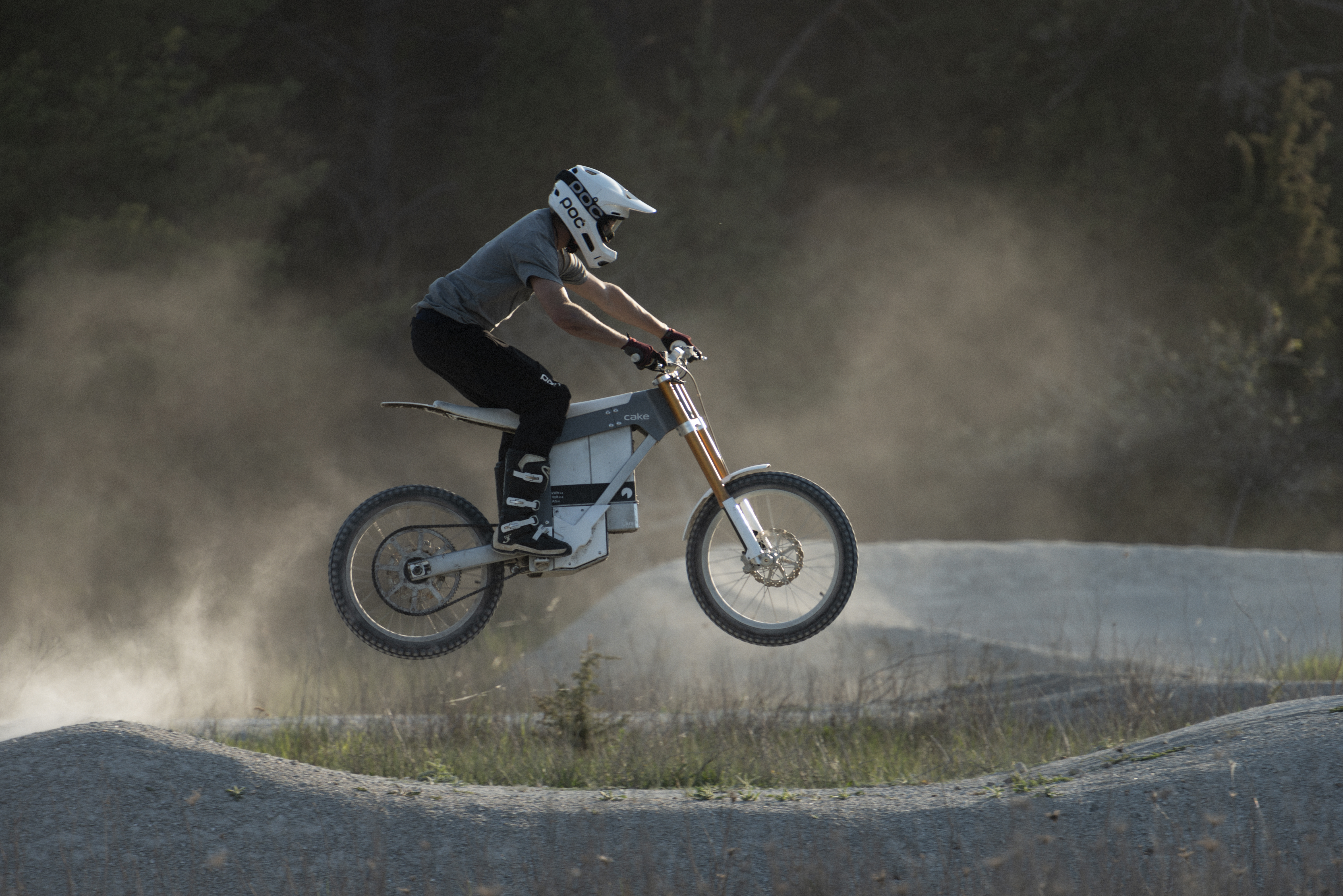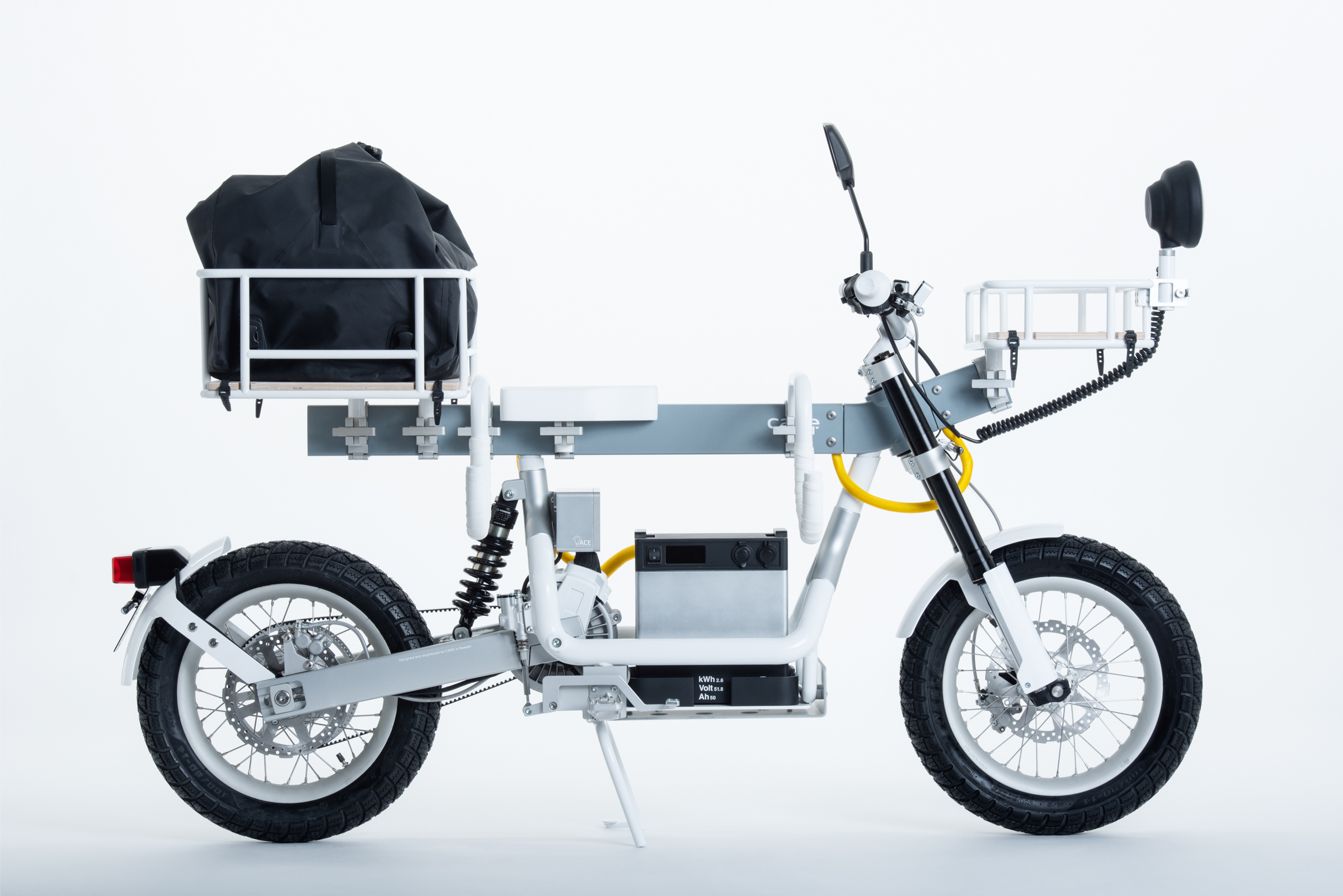Cake has crafted the Swedish edition of electric motorcycle design starting in the dirt.
The Stockholm based mobility startup’s debut, the Kalk OR, is a 150 pound, battery powered two-wheeler engineered for agile off-road riding and available in a street-legal version.
On appearance, Cake’s Kalk has a minimalist stance and doesn’t evoke “motorcycle” in any conventional sense.
That was intentional, according to the company’s CEO, Stefan Ytterborn — a design aficionado and serial founder — who was more of a mountain biker and skier than a motorcyclist, before launching Cake with is two sons Karl and Nils.
“I wasn’t a motorcycle geek…I actually learned how to ride a motorcycle,” he explained on his foray into the business.
Ytterborn has worked in design development his entire career, leaving Sweden for Milan in his early days, developing product lines for IKEA in the ’90s and founding several design oriented companies over the years.
His last venture — outdoor sporting gear venture POC — supplied Olympic gold medalist Bode miller and the U.S. Ski Team with helmets and optics before it was acquired by Investcorp in 2015 for a reported $65 million.

Cake’s Kalk OR, Image Credits: Cake
Ytterborn’s current company shares some similarities with POC, namely creating products for natural forward motion in the outdoors.
The direction for Cake — according to its founder — was to design a motorcycle from a clean slate, harnessing the advantages of what voltage power could offer to the form.
“I was stoked by the idea of what an electric drive-train could bring,” Ytterborn told TechCrunch . “But then I started realizing nobody is really optimizing the performance of the electric drive-train. Everyone’s trying to imitate what the combustion motorcycle does,” he said.
One of the first things Ytterborn took from that view was engineering a lighter platform with a better power to weight ratio.
A distinguishing characteristic of most e-moto offerings, including the few oriented toward off-road use, is they are heavier than gas motorcycles. Even one of the lightest choices out there for street and dirt use, Zero’s FX, weighs nearly 100 pounds more than Cake’s Kalk OR.
The $13,000 Swedish e-motorcycle has a 2.6kWh battery, charges to 80% in an hour and a half using a standard outlet, and offers up to three-hours of off road ride time, according to Cake. The Kalk has 30 ft-lbs of torque and a top speed of 50 miles per hour.
The street legal version, the Kalk&, has similar specs with a mixed city/highway range of 53 miles. Both have capability for quick battery swaps and a second battery goes for $3,000.
Cake introduced an additional model in 2020, the $8,500 Ösa+, which the company characterizes as an urban utility moped with off-road capabilities.

Cake’s Ösa+, Image Credits: Cake
As a startup, Cake has raised $20 million in VC, including a $14 million Series A financing round led by e.ventures and Creandum in 2019.
The U.S. is a prime market for the company. Cake has a subsidiary in Park City, Utah, a U.S. representative — Zach Clayton — and is poised to open a sales store in New York City this quarter.
The company has sold 300 motorcycles in the U.S. this year and America makes up 60% of its sales market, according to its CEO.
On where the Cake fits into motorcycle market, “We’re much more Patagonia than Kawasaki,” said Ytterborn,
He described Cake as something developed for a far from static mobility world, where everything about how people move from A to B is being redefined, including the concept of the motorcycle.
That entails creating something that captures the exhilaration of riding off-road for an eco-conscious market segment, put off by the noise and fumes of gas motocross bikes.
“What really got me going was the intuition that we could flip the market upside down [with Kalk],” said Ytterborn.

Cake’s street legal Kalk&; Image Credits: Cake
“It’s silent, it doesn’t disturb, it doesn’t pollute and is the opposite of what non-motorcycle people associate with motorcycles,” he said.
The U.S. motorcycle market could use some fresh ideas, as it’s been in pretty bad shape since the last recession, particularly with young folks. New sales dropped by roughly 50% in 2008 — with sharp declines in ownership by everyone under 40 — and have never recovered.
At least one of the big gas manufactures — Harley Davidson — and several EV startups, such as Zero, are offering e-motorcycles as a way to convert gas riders to electric and attract a younger generation to motorcycling.
It’s notable that Harley Davidson acquired a youth electric scooter maker, Stacyc, in 2019 and has committed to produce e-scooters and e-mountain bikes as part of its EV pivot. The strategy is to use these platforms to create a new bridge for young people to motorcycles in the on-demand mobility world.
HD’s moves could provide some insight on where Cake might fit in that space. On one hand, the startup’s models could become premium electric motorcycles for the eco-friendly, Outside Magazine and action sports crowd. On the other, Cake could fill a new segment on the mobility product line — somewhere between e-scooters, e-bikes and traditional motorcycles.
“We want to establish a new category where people with an active lifestyle, whether they’re motorcycle people or not, can proceed with sustainability, responsibility and respect,” said CEO Stefan Ytterborn.
One challenge for this thesis could be Cake’s price and performance points compared to the competition. Zero Motorcycle’s FX, while heavier than the $13,000 Kalk, starts at $8,995 and has a top speed of 85 miles per hour.
Read Again https://techcrunch.com/2020/05/22/cake-brings-a-swedish-take-on-e-motorcycle-design-to-the-u-s/Bagikan Berita Ini














0 Response to "Cake brings a Swedish take on e-motorcycle design to the U.S. - TechCrunch"
Post a Comment